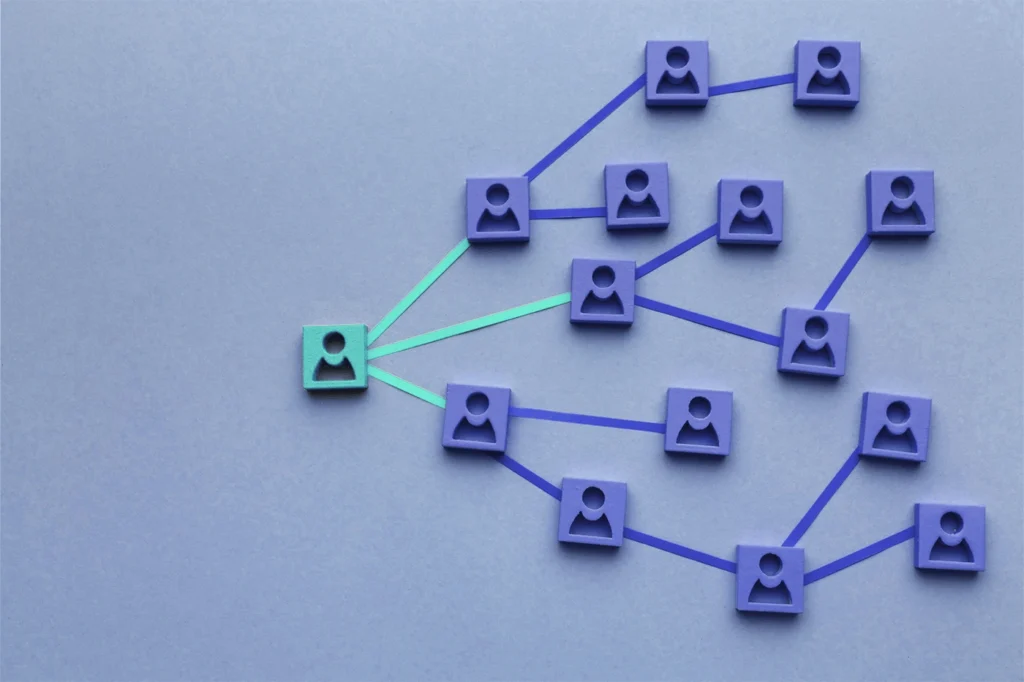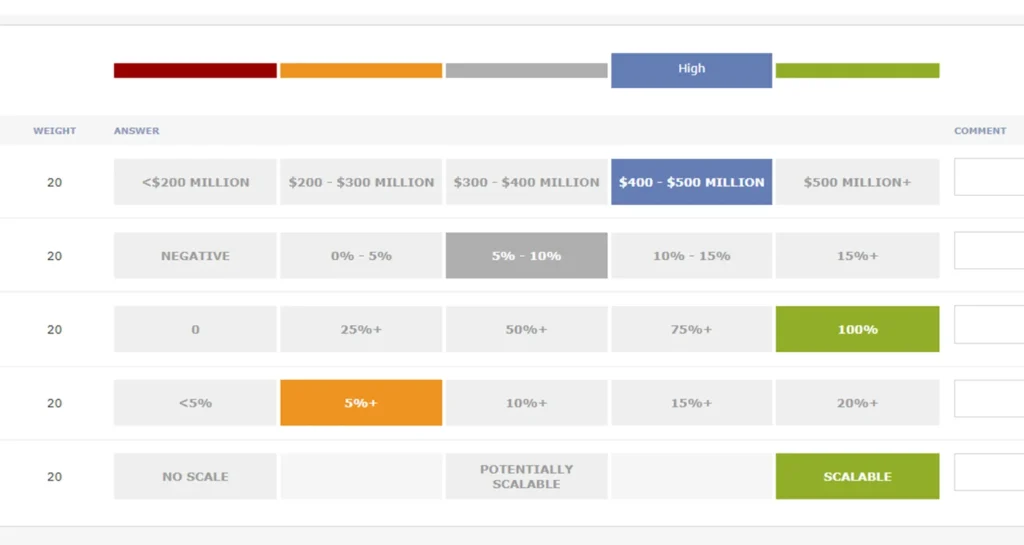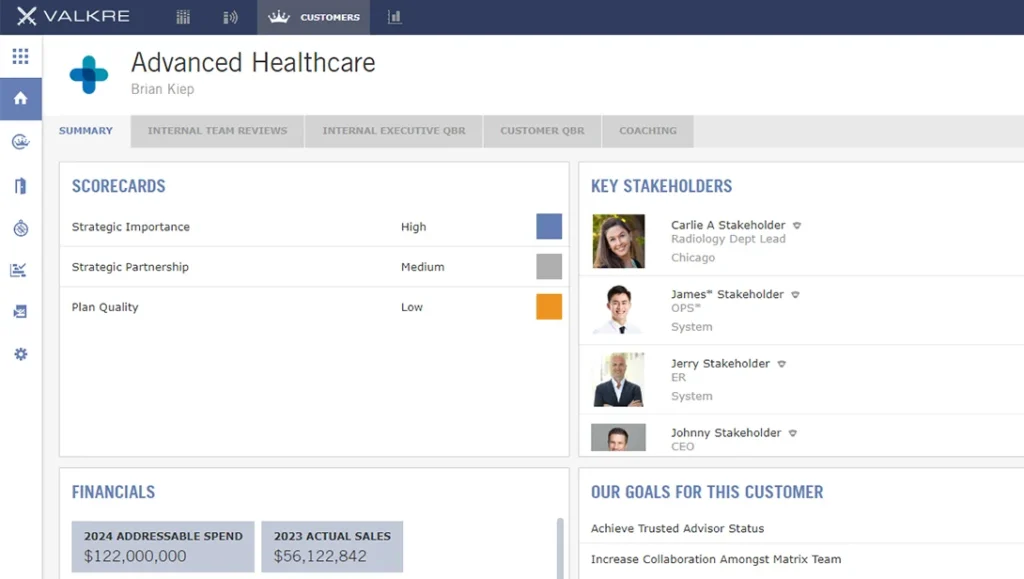In key account management (KAM), understanding who your stakeholders are—and how they influence decisions—is critical to driving growth. The more clearly you understand your stakeholders, the better your chances of retaining and expanding business within an account. However, identifying and managing stakeholders isn’t always straightforward, especially in complex organizations where decisions are influenced by many people, not just one.
This is a common challenge for account management teams. Without a structured way to assess influence and engagement, it’s easy to focus on the wrong people, overlook internal dynamics, or miss early warning signs of risk. Conversations may feel productive, but they won’t move the business forward if they’re not with the right stakeholders.
That’s where stakeholder analysis tools come in. These tools help teams identify key individuals, assess their level of influence and interest, and prioritize engagement efforts. When used effectively, they provide a clear view of the stakeholder landscape—who matters most, where to focus, and how to align your strategy accordingly.
In this post, we’ll explore the process of stakeholder analysis, the benefits of stakeholder analysis for key account teams, and how to use stakeholder analysis tools to improve account planning and execution. You’ll also get a closer look at how analysis connects to broader strategies like stakeholder or relationship mapping, and how to apply this thinking to real accounts.
What is stakeholder analysis?
Stakeholder analysis is the process of identifying the key individuals within an account, understanding their roles, assessing their level of influence and interest, and determining how they may impact or be impacted by your strategy. It’s a critical step in account planning that helps teams prioritize engagement and align resources where they matter most.
Unlike a static org chart, stakeholder analysis goes deeper. It reveals who actually influences decisions, where potential blockers exist, and which stakeholders are most likely to support your solution.
When supported by the right stakeholder analysis tools, this process gives account teams a clear, structured view of the people dynamics within a customer organization.
One of the most valuable outcomes of stakeholder analysis is the ability to create a stakeholder map—a visual representation of stakeholder connections, influence, and relationship strength.
Why stakeholder analysis matters
In key account management, decisions are rarely made by a single person. Most B2B organizations rely on buying groups of multiple stakeholders—each with their own goals, concerns, and levels of influence. Account teams can easily waste time engaging the wrong people or overlooking critical decision-makers without a structured understanding of these dynamics.
A well-executed stakeholder analysis and the proper stakeholder analysis tools allow account teams to:
- Clarify power structures. It identifies decision-makers, influencers, gatekeepers, and internal champions—so you know who to engage and how to prioritize them.
- Guide engagement strategies. It helps teams align messaging, cadence, and outreach based on stakeholder influence and interest.
- Align sales and account teams. Teams can collaborate more effectively and eliminate guesswork by creating a shared view of key players.
One key advantage of stakeholder analysis is its ability to feed directly into stakeholder mapping. Once you’ve identified and assessed your stakeholders, you can build a map to visualize connections, reveal gaps, and plan targeted engagement.
Common misconceptions about stakeholder analysis
Some teams view stakeholder analysis as a basic box-checking exercise—or confuse it with simply reviewing an org chart. But in reality, the process of stakeholder analysis goes much deeper and delivers far more strategic value.
- It’s not just about job titles. Org charts show reporting lines but miss informal influence and behind-the-scenes dynamics. A proper analysis surfaces internal advocates, blockers, and key decision-makers who may not have obvious titles.
- It’s not a one-time activity. Stakeholder priorities shift, people change roles, and new influencers emerge. An effective analysis—supported by the right stakeholder analysis tools—is something account teams revisit and refine over time.
When done well, stakeholder analysis helps teams avoid blind spots, uncover internal dynamics, and build stronger, more targeted engagement plans. It also lays the foundation for building a stakeholder map to visualize and act on those insights.
The role of stakeholder analysis in key account growth
Strong relationships drive account growth, but a single connection isn’t enough in complex organizations. That’s why understanding the full stakeholder landscape is so important. Stakeholder analysis tools help account teams identify key players, understand their influence, and shape smarter engagement strategies.
Understanding decision-making dynamics
In most B2B environments, buying decisions are shaped by a group—not a single person. Some stakeholders hold decision-making power, while others influence behind the scenes. Without clear visibility into this network, account teams risk engaging the wrong people and missing those who truly impact the deal.
Stakeholder analysis helps account teams differentiate between:
Decision-makers – Those with final approval authority
Influencers – Individuals who help shape opinions and outcomes
Gatekeepers – People who control access to decision-makers
Champions – Internal advocates who can help advance your solution
Blockers – Stakeholders who may resist or delay progress
By clearly identifying each stakeholder’s role and level of influence, account teams can focus their time and resources where it matters most.
Strengthening relationships to drive revenue
One of the biggest risks in key account management is the single-threaded relationship—when an account manager relies too heavily on one contact within the organization. If that person leaves, changes roles, or loses influence, the entire relationship—and the revenue tied to it—can be at risk.
Stakeholder analysis tools help prevent this by encouraging teams to take a broader, more strategic view of the account. With the right analysis in place, account teams can:
- Identify key allies. Understand which stakeholders support your company and where your relationships are strongest—or weakest.
- Expand engagement. Move beyond a single point of contact by developing connections with multiple decision-makers and influencers.
- Deepen trust. Build regular, meaningful interactions across departments and levels, not just with familiar faces.
By using the process of stakeholder analysis to uncover gaps and opportunities, teams can create more resilient account strategies. A well-maintained stakeholder analysis initiative ensures that strong connections exist across multiple levels of an organization, reducing risk and improving long-term account growth.
How to use stakeholder analysis to build a stakeholder map
Understanding who matters inside your customer’s organization is essential to managing and growing key accounts. Stakeholder analysis tools help you identify the right stakeholders, assess their influence, and plan smarter engagement strategies.
But analysis is just the start. The real power comes when you turn those insights into action. Combining stakeholder analysis with a relationship map gives you the strategic thinking and visual clarity to engage accounts confidently.
Here’s how to go from analysis to action in six steps:
Step 1: Gather Stakeholder Data
Start by collecting information about everyone involved in the account. Use sources like:
- CRM systems to review past engagements and deal history
- Internal team insights for first-hand knowledge of relationships
- LinkedIn and public data to understand reporting lines and roles
Look for signals of involvement and influence. Who’s active in meetings? Who seems to shape internal conversations? Who might be missing?
Step 2: Identify and Categorize Stakeholders
Next, list all relevant stakeholders and group them by role. You don’t need to analyze every contact. You need to identify the few who matter most to your strategy. Common types include:
Decision-makers – Hold final approval authority
Influencers – Shape recommendations or opinions
Gatekeepers – Control access to decision-makers
End-users – Use your product and can influence adoption or renewal
Blockers – Resist change or favor competitive options
You may have dozens of contacts in an account, but your stakeholder map should focus on the few individuals who truly impact your ability to retain and grow the relationship. This could be as few as five to seven key stakeholders.
Step 3: Assess Influence, Interest & Relationship Strength
Using a stakeholder assessment matrix, evaluate each person’s:
Level of influence – Are they high, medium, or low in the decision process?
Level of interest – Supportive, neutral, or resistant to your solution?
Relationship strength – Strong, neutral, or weak based on current interactions?
This assessment reveals both opportunities and risks. A high-influence stakeholder with a weak relationship is a red flag. A supportive end-user with low formal power might still be a valuable advocate.
Step 4: Map Stakeholder Dynamics
Now that you’ve completed the core analysis, you can visualize the results with a stakeholder map. The best stakeholder maps don’t just show who’s who—they show who wants what, and how your team can help them get it. Use this to show:
- Stakeholders and their roles
- Goals and primary projects
- Influence levels and relationship strength
- Reporting lines and informal influence networks
Mapping a stakeholder’s goals and strategic initiatives is just as important as mapping their influence. What do they care about? What outcomes are they accountable for? This information shapes how you engage and what value you deliver.
Much of this process is streamlined and dynamic if you’re using a tool like Valkre. Otherwise, use slide decks, diagramming tools, or even whiteboards to create a clear, shareable map for your team.
Step 5: Build Engagement Strategies
With your map in hand, shift your focus to action. Use your analysis to:
- Strengthen weak relationships by increasing relevant, valuable touchpoints
- Leverage strong allies to gain access or influence across the account
- Address blockers with tailored messaging or new champions
- Personalize engagement with each stakeholder’s priorities and level of influence
This is where stakeholder analysis becomes more than a strategy exercise—it becomes a tool for real growth.
Step 6: Maintain and Evolve Your Strategy
Stakeholders change. People leave. New priorities emerge. To stay aligned:
- Review your analysis and map regularly, especially before renewals or major proposals
- Update your strategy with insights from recent conversations or account changes
- Refine engagement plans based on how relationships develop over time
A strong stakeholder strategy isn’t a one-time task—it’s a living asset that should evolve with the account.
Bringing it all together
Combining stakeholder analysis tools and relationship mapping gives account teams clarity and control over even the most complex accounts.
Stakeholder analysis provides the foundation: who matters, how they think, and where to focus.
Stakeholder mapping brings it to life: visualizing connections, identifying gaps, and enabling collaboration.
Together, they help you move from guesswork to growth—with a clear strategy built on data, insight, and shared understanding.
Turn stakeholder analysis into a growth strategy
Strong relationships are at the core of key account success, but without a clear understanding of your stakeholders and how they influence decisions, even the best sales efforts can stall.
Stakeholder analysis tools help you uncover the internal dynamics that drive buying decisions, identify key influencers, and prioritize the most important relationships. When paired with a stakeholder map, this analysis becomes a powerful guide for action—helping your team align, engage, and grow the account with purpose.
Following the steps outlined in this post, you can start building your stakeholder strategy—identifying the right people, assessing their influence, and turning insight into engagement.
If you’re looking for a KAM platform with built-in stakeholder analysis mapping, request a demo of Valkre today and see how it can help you manage and grow your most important accounts—smarter and faster.



